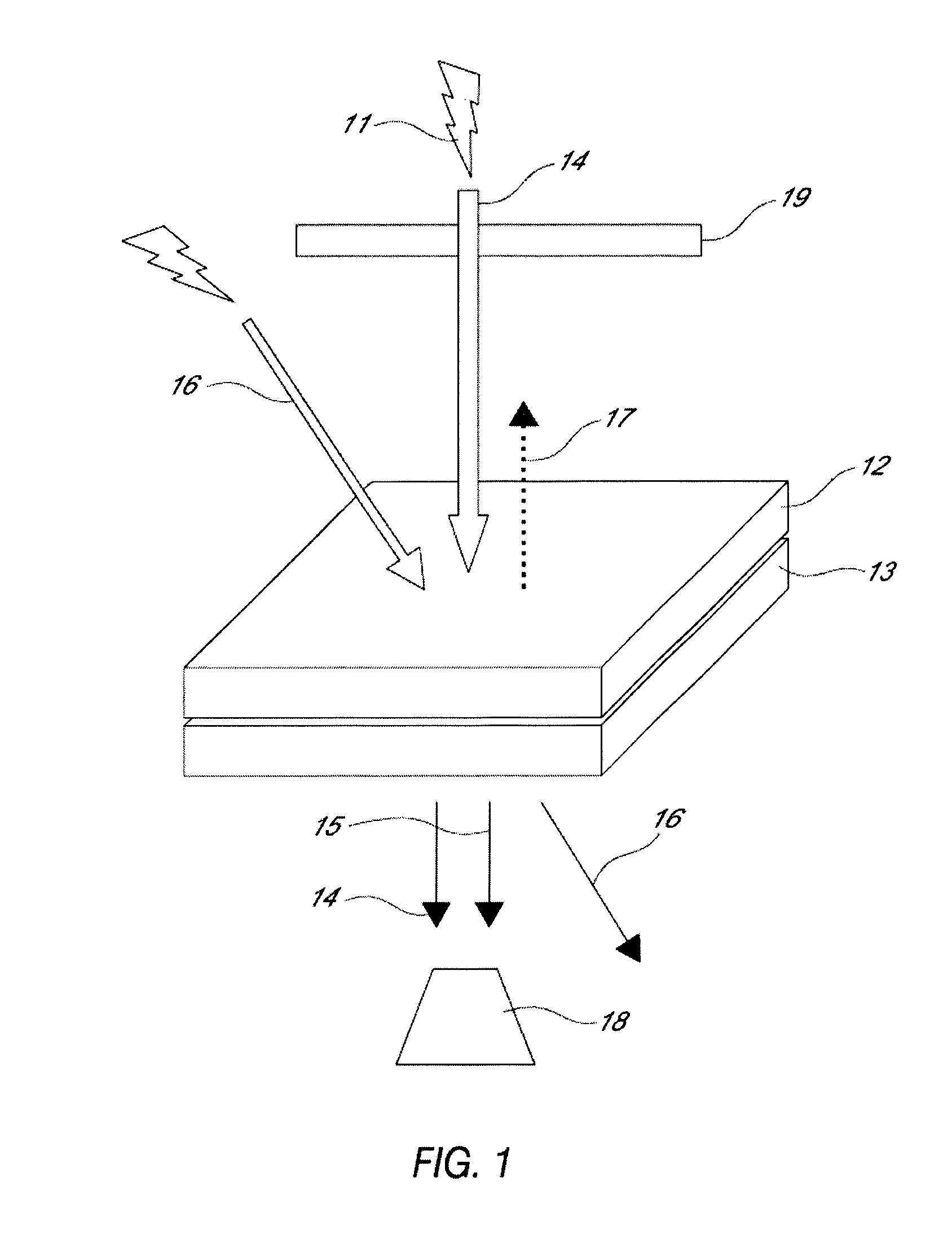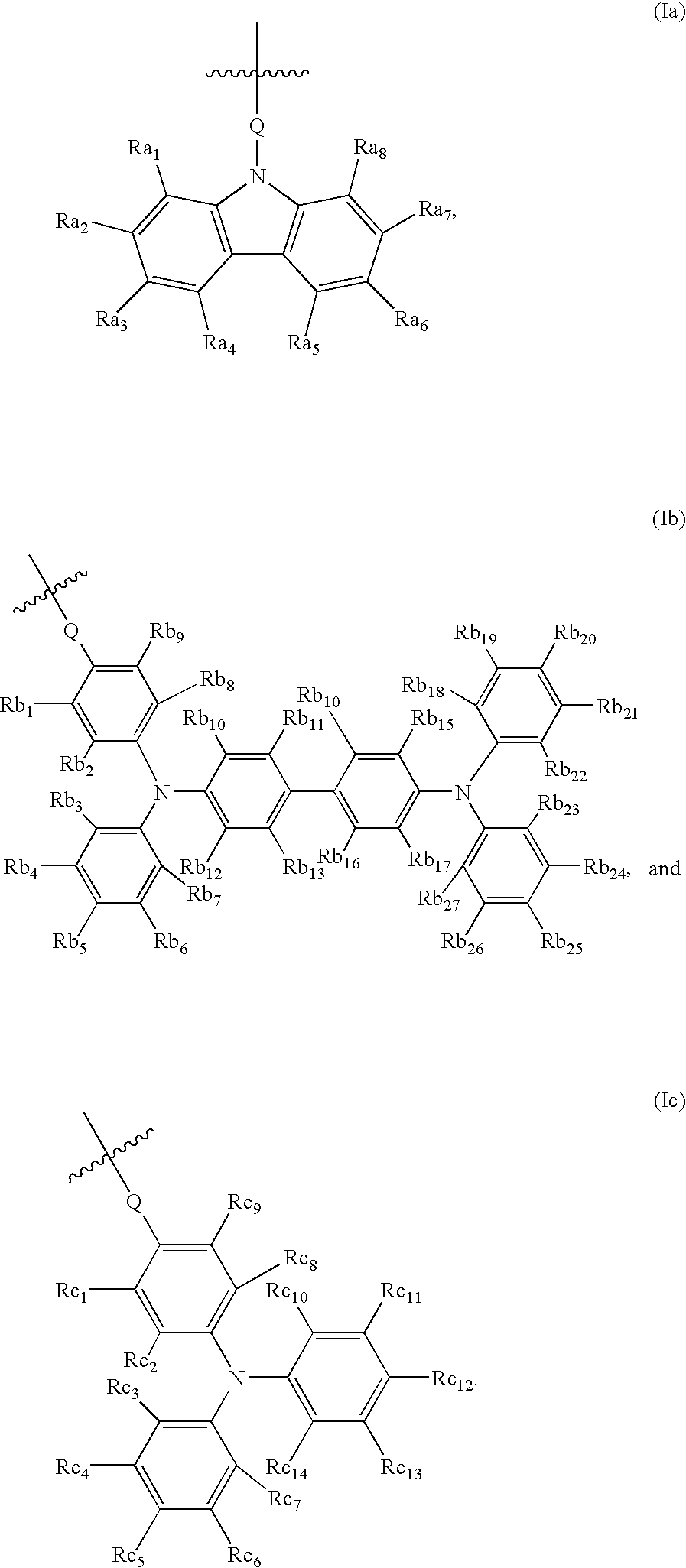Optical devices responsive to near infrared laser and methods of modulating light
a near infrared laser and optical device technology, applied in the field of photorefractive compositions, can solve the problems of high diffraction efficiency, failed photorefractive performance, and failed to show high diffraction efficiency, and achieve fast response time, large two-beam coupling gain, and good diffraction efficiency
- Summary
- Abstract
- Description
- Claims
- Application Information
AI Technical Summary
Benefits of technology
Problems solved by technology
Method used
Image
Examples
example 1
(a) Monomers Containing Charge Transport Groups
[0091]N-[acroyloxypropoxyphenyl]-N,N′,N′-triphenyl-(1,1′-biphenyl)-4,4′-diamine (TPD acrylate) monomer was purchased from Fuji Chemical, Japan, and has the following structure:
(b) Monomers Containing Non-Linear Optical Groups
[0092]The non-linear optical precursor monomer 5-[N-ethyl-N-4-formylphenyl]amino-pentyl acrylate was synthesized according to the following synthesis scheme:
[0093]STEP I: Bromopentyl acetate (5 mL, 30 mmol), toluene (25 mL), triethylamine (4.2 mL, 30 mmol), and N-ethylaniline (4 mL, 30 mmol) were added together at room temperature. The mixture was heated at 120° C. overnight. After cooling down, the reaction mixture was rotary-evaporated to form a residue. The residue was purified by silica gel chromatography (developing solvent: hexane / acetone=9 / 1). An oily amine compound was obtained. (Yield: 6.0 g (80%)).
[0094]STEP II: Anhydrous DMF (6 mL, 77.5 mmol) was cooled in an ice-bath. Then, POCl3 (2.3 mL, 24.5 mmol) was ...
example 2
Preparation of TPD Acrylate / Chromophore Type 10:1 Copolymer by AIBN Radical Initiated Polymerization
[0117]The charge transport monomer N-[(meth)acroyloxypropylphenyl]-N,N′,N′-triphenyl-(1,1′-biphenyl)-4,4′-diamine (TPD acrylate) (43.34 g), and the non-linear optical precursor monomer 5-[N-ethyl-N-4-formylphenyl]amino-pentyl acrylate (4.35 g), prepared as described in Example 1, were put into a three-necked flask. After toluene (400 mL) was added and purged by argon gas for 1 hour, azoisobutylnitrile (118 mg) was added into the solution. Then, the solution was heated to 65° C., while continuing to purge with argon gas.
[0118]After 18 hours of polymerization, the polymer solution was diluted with toluene. The polymer was precipitated from the solution and added to methanol, then the resulting polymer precipitate was collected and washed in diethyl ether and methanol. The white polymer powder was collected and dried. The yield of polymer was 66%.
[0119]The weight average and number avera...
example 3
Preparation of Photorefractive Composition
[0120]A photorefractive composition testing sample was prepared. The components of the composition were as follows:
(i) TPD copolymer charge transport (described in Example 2):50.0 wt %(ii) Prepared chromophore of 7-DCST:35.0 wt %(iii) 9-ethylcarbazole plasticizer:13.0 wt %(iv) DBM sensitizer 2.0 wt %
[0121]To prepare the composition, the components listed above were dissolved in toluene and stirred overnight at room temperature. After removing the solvent by rotary evaporator and vacuum pump, the residue was scratched and gathered.
[0122]To make testing samples, this powdery residue mixture was put on a glass slide and melted at 125° C. to make a film with a thickness of about 200-300 μm, or pre-cake. Small portions of this pre-cake were taken off and sandwiched between indium tin oxide (ITO) coated glass plates separated by a 100 μm spacer to form the individual samples.
Measurement 1: Diffraction Efficiency
[0123]The diffraction efficiency was...
PUM
| Property | Measurement | Unit |
|---|---|---|
| thickness | aaaaa | aaaaa |
| thickness | aaaaa | aaaaa |
| transmittance | aaaaa | aaaaa |
Abstract
Description
Claims
Application Information
 Login to View More
Login to View More - R&D
- Intellectual Property
- Life Sciences
- Materials
- Tech Scout
- Unparalleled Data Quality
- Higher Quality Content
- 60% Fewer Hallucinations
Browse by: Latest US Patents, China's latest patents, Technical Efficacy Thesaurus, Application Domain, Technology Topic, Popular Technical Reports.
© 2025 PatSnap. All rights reserved.Legal|Privacy policy|Modern Slavery Act Transparency Statement|Sitemap|About US| Contact US: help@patsnap.com



